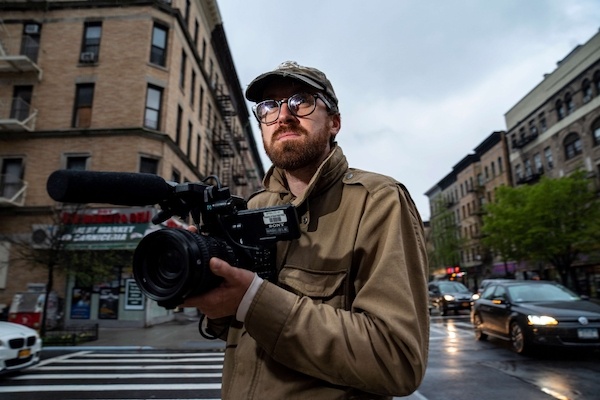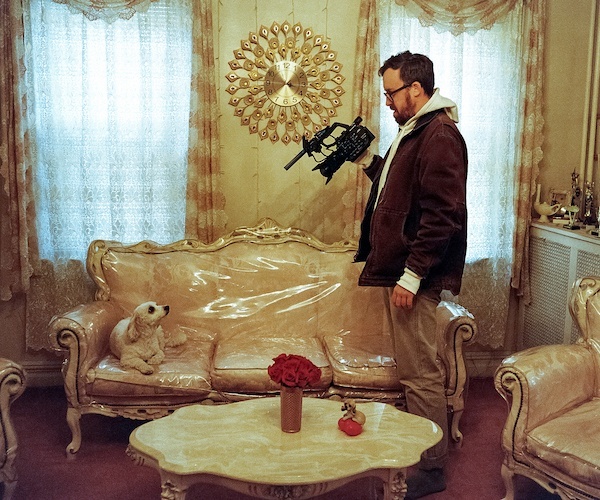Television Interview: Talking with John Wilson, the Mastermind behind HBO’s “How to with John Wilson”
By Sarah Osman
“I don’t want to show myself because I don’t think I’m very interesting to look at. The world is filled with so many other interesting things to look at.”

John Wilson on the video hunt for answers in How to with John Wilson. Photo: courtesy of the artist.
For the past five Fridays, HBO has been airing How to with John Wilson, a documentary series in which documentarian John Wilson tries to find answers to simple questions, such as How to Split the Check? or How to Cover Your Furniture? The series is set in New York (though select episodes move to other locations) and serves up a much more realistic version of the city than is usually found on screen. Part video essay, part documentary, and part anthropological study, How to with John Wilson focuses on the trials and tribulations of life in the city. Each episode is sparked by a simple idea whose significance grows, generating larger themes and metaphors. The final episode of Season 1 of How to with John Wilson premieres Friday on HBO at 8 p.m. EST
Wilson has been making documentary shorts since 2010 (which can be watched on Vimeo), but it was a chance encounter with Nathan Fielder (Nathan for You) that brought about his show on HBO. Since the premiere, How to with John Wilson has received rave reviews (including my own). I was curious to learn more about the mystery man behind the camera. Wilson was gracious enough to give me a peek into his process:
Arts Fuse: Hi John, how are you?
John Wilson: Good. I just saw that Jake Tapper just tweeted about the show, which is so funny. None of this feels real, yet all of it feels real. I don’t know how. The only real proof or evidence that people are watching my show is that one person recognized me in the supermarket, and that’s about it. Everything else has been on the internet.
AF: So I have a few questions for you. What is it like to work with Nathan Fielder, and how did the show come about between you two?
JW: Nathan and I met by chance. It’s like how most everything I do comes together. We were at a restaurant in Chinatown. He recognized me from a movie that I had made that was circulating. I will never get to release the film because it’s not legal to show it anymore. Essentially, I faked my way onto these court TV shows. I got a cease and desist order. The film is circulating privately and he saw it. We exchanged numbers that night and hit it off. We had a long dinner together. We then developed a pitch, a more ambitious version of my short films, which he had also seen. We shopped it around to a few networks. HBO was the obvious choice for me because they don’t have any commercials in the middle of their shows. I wouldn’t have to turn it into a three or four act structure. Then we made the show together. He was there most of the time, whether in the edit or on the phone with me as I was filming. It was a very intense collaboration.
AF: You have a background filming infomercials, which are often about the absolutely mundane. Did this encourage you to create a show in which you only filmed the interesting things you encountered?
JW: Yes. The stuff I was filming for infomercials was drab. It was logo based. It was some of the most reprehensible imagery you could conjure up. I wanted my own work to be the complete opposite of that. I think it definitely influenced me. Everything that I was told not to do in a professional capacity I did then in my own work. For example, whenever you are working with a producer, they always say don’t make it look like a pole is coming out of a subject’s head. Don’t place your subjects in front of a pole or a plant because it makes it look as if there is something coming out of their heads. That was one of the first things I did. In one of the interviews, I put someone in front of a smoke stack so it looked like his head was smoking. It was something you can’t get away with if you are working for some stooge for money.
AF: Are there any documentarians that you admire, such as George Kuchar?
JW: I am a fan of Kuchar. I like Penelope Spheeris. She is best known for directing Wayne’s World, but she also made The Decline of Western Civilization movies, which are so excellent. Those are like a gold standard for me in terms of talking head interviews. I love Fredrick Wiseman. There’s a long list of documentarians. I also like Nick Broomfield. The list goes on and on. Everyone has become used to the Alex Gibney style of documentary these days, where you have a graphic package, a sexy title sequence, and plenty of pundits. It serves a purpose, but I don’t think that’s always the best use of the genre.
But it’s not just documentaries that inspires me. I also like a lot of literary essayists. A lot of my work feels like an essay. There are a lot of essayists who I admire, such as Rebecca Solnit and Janet Malcolm. Sheila Isenberg wrote the great book Women Who Love Men Who Kill, which is all about women who go and try to marry convicts who are in prison for life. The essayists I like do an amazing job of taking a historical event and making it personal at the same time. They are constantly seesawing between the two. That’s what I really want to channel in my own work. I want to tell a personal story within a larger context.
AF: You shoot an enormous amount of footage. You have a second unit team also shooting. Is there material that you wished you could have included that was cut?
JW: I have included most of what I wanted to use. In the show, you’re only seeing the tip of the iceberg. I love all of the footage almost equally. (chuckles) I have enough material for several seasons. One day, hopefully, I’ll be able to use it in something else. The footage doesn’t expire. I think it’s important that I captured it before the moment disappeared. In terms of something specific, I’m not sure. There’s a lot of funny stuff, such as people overloading their cars with mattresses and having them fly out on the highways. It’s stuff that didn’t necessarily fit into the show’s overarching metaphor or one of the larger ideas. Maybe I’ll write something specifically for this footage in the future, but it’s in an archive for now.

John Wilson and animal subject in How to with John Wilson. Photo: Aaron Berger
AF: Will you reveal more of yourself as the show goes on? For instance, we are given a glimpse of your cat and apartment. Is this version of John Wilson another character? Or do you feel that you are exposing the real you?
JW: I would say it’s the real me. It’s my real cat. It’s my real apartment. I think it’s so funny, when we were pitching the show, the network was bothered by the fact that you didn’t see me. I show more of myself in this show than any show host ever has. You are seeing my actual ex-girlfriend. This is deeply personal stuff. You are seeing my personal archives, my journals, my calendars. For some reason, people still think I’m absent because you don’t actually see me. I think that I would be the least interesting part of the image, and that’s why I don’t want to show myself. Everybody on YouTube or on any blog — all you see is the host. Everything looks the same, and it’s so boring. The most interesting stuff is pointing in the other direction. I don’t want to show myself because I don’t think I’m very interesting to look at. The world is filled with so many other interesting things to look at.
AF: Your show does visit a few other places, but it is primarily set in NYC. Many artists tend to focus on a certain city, such as Tennessee Williams and New Orleans. Have you thought of expanding the series to focus on different cities or, as a New Yorker, do you prefer to focus on your own city?
JW: I could focus on different cities if a story brought me there. I like New York being a home base. It’s my favorite subject. It changes faster than any other city, and that’s what I like to chase. I like to chase the disappearing stuff, which is tragic, but that’s what makes New York such a fascinating place to document. Everyone has a relationship with it as a city from all over the planet. There’s a nostalgia for New York, whether it’s triggered by movies or books. I really like to offer the kinds of images that people don’t usually see. New York is usually depicted the same way over and over again. I think it’s such a shame that people think they need to close down the street to reenact what is happening in New York for a movie. I think that’s the worst impulse. Everything is already there. There’s all this raw material that’s rich already. The fact that you have to dramatize it somehow is a waste of money and effort.
AF: Can we get a sneak peek of Season 2?
JW: I never stopped shooting. It’s just going to be constantly rolling. I haven’t been greenlit yet, but I have a meeting with HBO on Monday. The show seems to have been received pretty well. But I have no idea. For Season 2, I want to capture as much of COVID New York as I can. It may seem like the pandemic is going to be going on forever, but the city may not look like this for much longer. By the time all of this passes, I don’t want to regret I didn’t document it in my own way. The city looks more interesting now that it has my entire life. I want to explore the limitations of COVID, lean into them, and see where that takes me. It’s tough, because I don’t want to acknowledge COVID so much as I want it to be the aesthetic. Everybody is doing the whole COVID thing. There are these stupid shows coming out, like Zoom entertainment. It’s psychotic that people think that Zoom calls would be entertaining (laughs).
Sarah Mina Osman is a writer living in Los Angeles. She has written for Young Hollywood and High Voltage Magazine. She will be featured in the upcoming anthology Fury: Women’s Lived Experiences under the Trump Era.

[…] I recently had the chance to chat with the lovely John Wilson of How to with John Wilson! I got to learn a lot about his show and process. Take a look: https://artsfuse.org/216561/television-interview-talking-with-john-wilson-the-mastermind-behind-hbos… […]
this is a beautiful interview! thank you!
Thank you for the great interview.